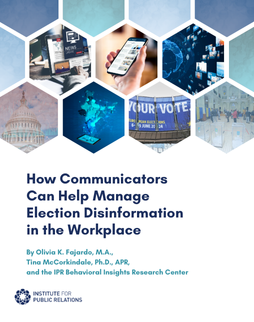The Holy Grail for global business executives today is employee engagement. Recent studies indicate that close to 85% of employees believe they can positively impact quality of their organization’s products and services. The sad truth though is that those same studies indicate less than 1/3 of employees globally are actively engaged in their jobs.
Engagement is about individual behavior. People who have both an emotional and intellectual bond to the organization. Disengaged employees not only exhibit less than satisfactory behavior as it relates to performance, they actually produce less revenue for the business.
It is for these reasons that leaders and communicators alike are spending significant resources to uncover the elements of engagement.
How so? Rather than do what they’re supposed to do – serve as a means for employees to advise leadership on the effectiveness of its management or operating model – they instead get used by HR and communications departments to gauge morale and awareness.
The workforce, sensing this, generally responds in one of two ways: by telling management what it wants to hear, or by truthfully professing any ignorance or confusion about the company’s strategic direction. The first approach accomplishes nothing positive beyond a back-slapping opportunity for management, and the second approach is more often than not used as the impetus to establish meaningless “morale committees” or “culture task forces.”
An Outcome Not a Goal
The reason for such misdirection is that often organizations define “engagement” as a goal or even a strategy when in fact, it’s an outcome.
Real engagement happens as a result of a number of interrelated actions including but not limited to: management behaviors; open and transparent culture; participatory decision-making; clear and consistent communications; team-oriented project management; rewards and recognition efforts; and compensation policies.
Check out the employee engagement survey practices of some of the leading management consulting and research firms, and you’ll see that these surveys usually aren’t really conceived to engage at all; they’re conceived to generate statistically laden checklists and metrics to provide managements with insight into the shortcomings of their workforce.
This isn’t a clarion call for the abolition of engagement surveys. Quite the contrary: approached properly – as a referendum on leadership – and they can be highly valuable. The key, of course, is to approach them the right way.
Some enlightened organizations do that already. Consider the following input gleaned from a variety of top-tier companies.
“We’re proud of what we do: we view our engagement surveys as a core strategic, competitive edge,” says a senior communicator at a large manufacturing company. “We believe the more highly engaged our associates are, the more productive they are. We implement a new survey every one or two years. We don’t sugarcoat our results (for senior management). Our executives talk about the results often and build engagement into our enterprise targets.”
Another manager notes that engagement surveys can also uncover cases of senior management being tone deaf. After a downsizing, for example, many employees used the survey to voice displeasure that former colleagues’ offices were left untouched – down to empty coffee cups still sitting on the desks. “It was bizarre,” he notes, and employees weren’t happy about it. The survey offered a safe haven for employees to raise the subject – not a communications issue, per se, but one that absolutely impacted engagement.
Bingo! That’s the crucial point: before even embarking on an engagement survey, commit to doing so for the right reason: to gather useful, previously unknown and under-considered information that senior management will absorb and respond to! Not through “morale committees” that put the impetus for change on employees, but through new approaches to engaging employees’ minds and hearts.
“It’s not about hearts and flowers,” says a senior communications officer at an industrial company. “It’s about shoring up gaps. Employees need to know that the feedback they provide results in real action.”
Getting the most from Engagement Research …
- Above all, instead of just tracking and reporting on engagement across a spectrum of areas such as “management interaction” or “adherence to values” compile an overall statement reflecting the situation pointing to the organization’s management model. Doing so mitigates the knee jerk reaction to apply actions against each of the areas vs. developing an overall strategy.
- Recognize the real audience. It’s not employees! The real audience is leadership! Engagement is an outcome of the company’s current management model. If you believe employees are the audience, then all the effort is communicating results of the survey back to them instead of fixing the areas they identified.
- Make engagement an organizational priority! Once the results are in, assemble the right people from around the business to determine how best to address the findings leading to a holistic effort that improves engagement.
- Be consistent: implement these surveys at least once a year. One communicator interviewed above says his organization implements “mini surveys” in the years between more extensive surveying.
- Be objective: for most companies, it makes sense to engage a third party to implement and analyze engagement surveys, to avoid bias and make employees more confident their anonymity will be preserved.
- Finally…be level-headed: Almost as bad as ignoring feedback is responding too aggressively, too quickly. Take the time to truly assess the feedback and what it says about the effectiveness of current leadership policies and decisions.
A New Approach
Here are three things to avoid when developing research:
1) Ill-designed – Check your questions and determine if the answers actually provide any insight into how people behave. Many engagement surveys only address what people say about involvement or communications or knowledge sharing or collaboration. For example, engagement surveys typically ask “what is the best way to receive information about the company’s strategy or direction”, and the typical response from employees is ‘though my manager/supervisor.” However, in today’s matrix-structured organizations, interaction with managers is often limited due to organizational design. Without a major overhaul, this is not helpful. Instead, have the survey ask about the interactions with managers taking place today and how they might be improved.
2) Action Dis-Oriented – The survey or research must be conducted to enact a new set of actions within the organization led by management to improve the overall relationship between the company and its workforce.
3) Myopic – So much engagement research places the employees in a proverbial box in terms of their ability to answer holistically. For example, “what types of content would you like on our portal that would lead to your increased involvement in the organization?” The responses to this question often cite “more information on our vision, strategy, priorities, etc.” However, employees may or may not even be going to the portal with any regularity as to know what’s already there! The question forces to people answer in an artificial manner.
The Real Value
Establishing and maintaining engagement internally is all about integration and alignment. In the end, research is meant to identify the areas in which engagement is being thwarted or advanced including the organization’s management model or how it manages the enterprise.
The results of any research must be dissected and shared among all key functions comprising the management model so that a proper solution can be devised and enacted. Having individual groups or teams run around implementing tactics without any cohesion is a waste of time and resources leaving employees confused and cynical and the business itself less than optimal.
Gary F. Grates is President/Global Managing Director of Edelman Change and Employee Engagement, the organizational communications counseling practice of Edelman, the world’s largest independent public relations/communications counseling firm and the third largest overall.




Excellent article Gary.
I’d like to add (from an employee survey research specialist perspective) that the move towards a ‘one size fits all’ survey approach, especially when, supposedly linked to employee engagement is just plain wrong.
Each organisation is unique and therefore any research undertaken must take this into account – using a ‘one size fits all’ general survey will not provide the information the organisation needs.
Thanks for the opportunity to share.
Gary Cattermole
Partner | The Survey Initiative
http://www.surveyinitiative.co.uk
Gary — This is an excellent contribution, consistent with my experience in conducting employee engagement research and developing meaningful action plans. Peter Drucker often said, starting decades ago, that the primary goal of a business is to satisfy customer needs; profit is the reward for doing this well. And note that this is contrary to senior managers who alienate employees by saying that building stockholder value is their primary goal. Adapting Drucker’s statement, building alignment of an employee with co-workers, with immediate managers, with their job function, with internal customers, with external customers, and with the company’s strategic direction is a primary goal for senior management; engagement and superior business results are the rewards for doing this well.